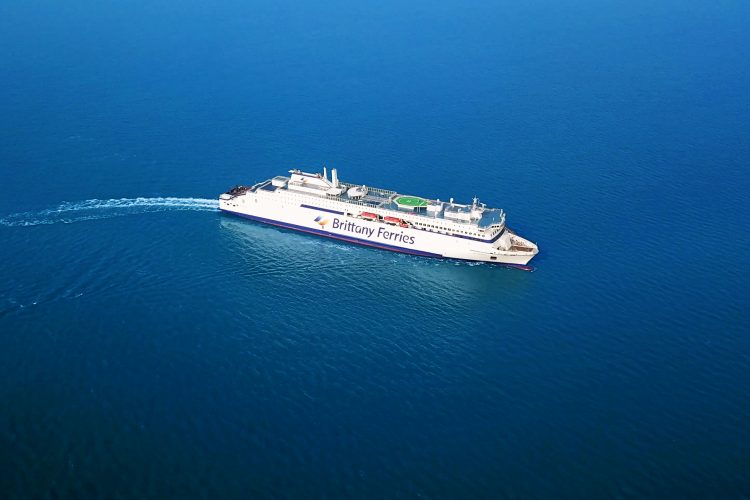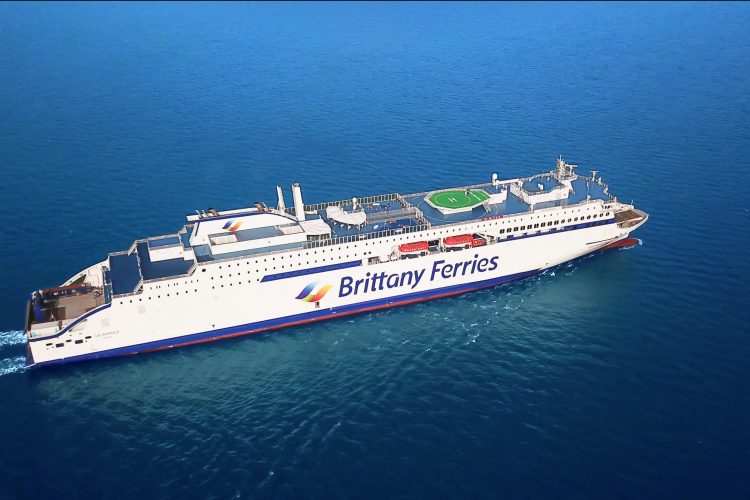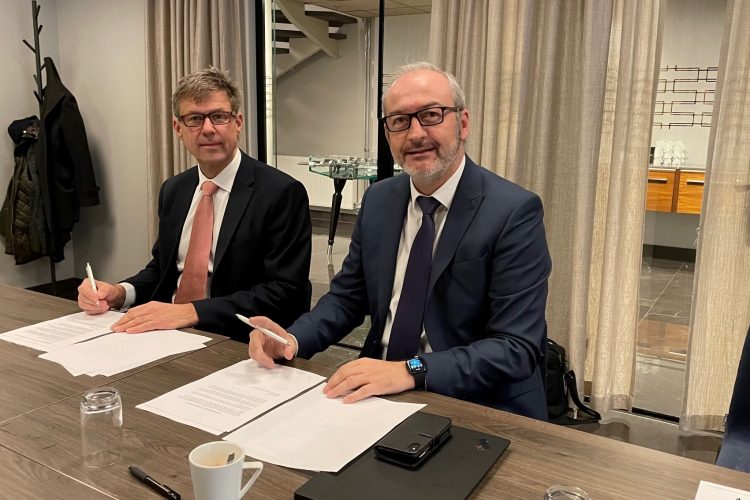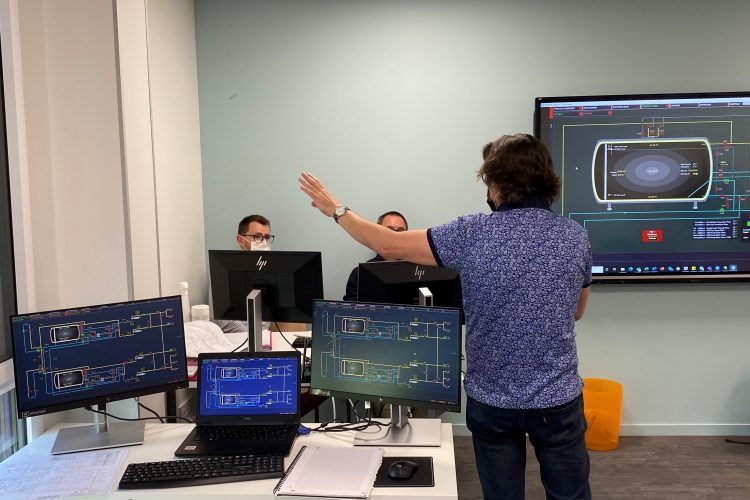Sea trials and simulators: Brittany Ferries takes delivery of Salamanca
Brittany Ferries today celebrates the delivery of its next vessel Salamanca. Senior executives including CEO Christophe Mathieu attended the hand-over ceremony in Sweden at the head office of construction partners Stena RoRo. Delivery refers to the transfer of ownership from ship builder to end user, rather than a voyage.
“Fleet renewal is key to our business strategy,” said Christophe Mathieu, CEO Brittany Ferries speaking from Sweden. “It is one of the pillars that will drive our recovery from the Covid crisis and deliver another successful 50 years for Brittany Ferries.
“So it is with gratitude that we thank our partners at Stena RoRo and everyone involved in her construction. From customers and suppliers, to the crew that will sail with her, we all look forward to welcoming Salamanca to the Brittany Ferries family ahead of her sister ship Santoña a year later.”
Sea Trials
Salamanca recently completed sea trials (see images). The tests took place on the Yellow Sea in China, with the ship under power by liquefied natural gas (LNG) for the first time.
Closer to home, preparation for her arrival in February 2022 is well under way. Brittany Ferries’ French crews are busy training. A dedicated LNG simulator opened at the company’s Atalante training centre in St Malo and has been used to train staff for the last two months.
Teams are learning the skills needed to bunker (re-fuel) Salamanca, as well as new safety procedures relating to a fuel that promises very few air quality emissions and lower CO2 upon combustion.
Work has also recently started on LNG bunkering terminals in the ports of Bilbao and Santander. These will store fuel for Salamanca and sister ship Santoña, the latter of which will join the fleet in 2023. Both vessels will serve UK-Spain routes.
Salamanca is the next ship in Brittany Ferries’ fleet renewal programme and the first to be powered by LNG. She is one of four new vessels to come in the years ahead, following the arrival of Galicia last December.
Salamanca and Santoña will be powered by LNG. Two hybrid LNG-electric vessels will follow in 2024/2025 as replacements for Bretagne (constructed in 1989) and Normandie (1992). The hybrids will carry passengers on routes connecting France with the UK and will be shore-side power ready.
Commenting on preparations for her arrival Mathieu added, “Our training centre at Atalante in St Malo is a state-of-the-art facility that was opened in 2019. It is equipping our sailors with the tools they need to be ready for Salamanca and her sister ships in the years to come.”
Jean-Marc Roué, president Brittany Ferries added: “Continued investment is necessary to ensure that we do not fall behind in the renewal of our fleet. More efficient and competitive ships are the guarantee of our recovery.”
Sea Trials – a summary
Sea trials serve two purposes for a new vessel. Firstly, they present the opportunity to test systems and sea-worthiness under realistic conditions for the first time.
This includes things like the main and auxiliary engines, pumps, alarms and safety systems such as firefighting equipment. The schedule also includes speed and manoeuvrability tests and an assessment of noise and vibration at sea. Propellor reversal tests demonstrate the ability of a ship travelling at top speed to stop within a limit specified in SOLAS* regulations.
Sea trials are also the opportunity for a ship builder to demonstrate to the end-user that contractual conditions have been met, paving the way to “delivery” of a vessel. Delivery refers to the passing of ownership from ship builder to user, rather than a physical voyage which in Salamanca’s case will take place from China to Europe in December.
LNG Simulator training for Brittany Ferries teams
With four LNG vessels on the horizon, Brittany Ferries has begun to instil a culture of gas-readiness among all staff. Training is of course key.
The LNG simulator in St Malo is a digital mock-up of the Salamanca‘s LNG fuel-loading, storage and preparation systems. It enables teams to be trained in their operation, reproducing any situation with which they may be faced.
Virtual bunkering (re-fuelling) can be undertaken in a wide variety of simulated situations. The simulator also allows staff to train in maintenance, and to practise specific procedures such as the complete shut-down of the LNG system.
This simulator is also compact and transportable. It can therefore be used for training onboard the ship when she arrives. Training modules were finalised in September and the first to undertake the programme have been Salamanca‘s crew who will be involved in LNG fuel operations.
*SOLAS – International Convention for the Safety of Life at Sea
-Ends-
Image captions
1/Staffan Stenfelt, General Manager Newbuilding Stena RoRo AB, and Christophe Mathieu, CEO Brittany Ferries
2&3/Salamanca on sea trials
4/ On board Salamanca
5/ Brittany Ferries crews undertaking LNG training in St Malo
https://brittanyferriesnewsroom.com/image_category/salamanca/
Video
Sea trial video: https://youtu.be/FcL8PhKEegE
About Brittany Ferries
Brittany Ferries was conceived in 1972, starting life as a freight-only service on 2nd January the following year. The first sailing linked Roscoff in Brittany with Plymouth in the South of England and carried a cargo of artichokes and cauliflowers. Since then the company has progressively launched, then strengthened shipping routes. Today millions of passengers and businesses transporting goods by sea across the so-called Atlantic Arc (France, UK, Spain and Ireland) rely on the links forged through six decades of operation. In addition to cutting congestion and emissions on busy roads, these motorways-of the sea have helped enrich local communities, creating jobs and nurturing international tourism.
More details here: https://corporate.brittany-ferries.com/en/press.aspx
Key figures (2020)
- Revenue: €202.4 million (€469 million in 2019)
- Fleet renewal: Four new vessels on the horizon, two powered by LNG entering service in 2022 and 2023; two LNG-hybrid powered ships arriving in the years that follow
- Employment: 2,474 employees, including 1,600 seafarers (full-time equivalent)
- Passengers: 752,102 in 2020 (2,498,354 in 2019)
- Freight: 160,377 in 2020 (201,554 in 2019)
- 12 vessels connecting France, the United Kingdom, Spain and Ireland, via 14 maritime routes
- 12 ports: Roscoff, Saint-Malo, Cherbourg, Caen, Le Havre, Plymouth, Portsmouth, Poole, Cork, Rosslare, Santander, Bilbao.
- Tourist impact: 231,000 unique visitors to France, generating 2.6 million overnight stays in 2020 (857,000 in 2019 with 8.7 million overnight stays in 2019)
Press contacts:
Nigel Wonnacott [email protected]
Christopher Jones [email protected]
 News
News




